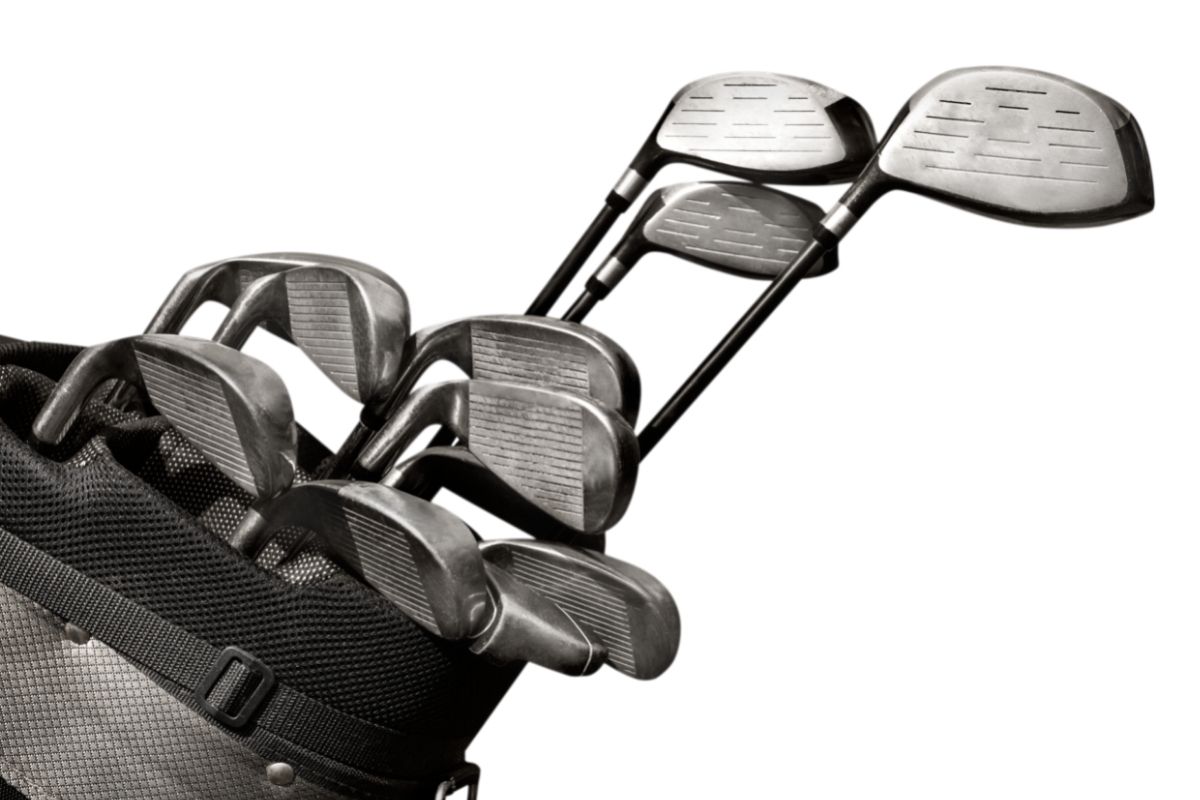We occasionally recommend products we love and might be paid a share of the sale.
If you’re just getting started in the world of golf, there are already about a million different concepts and technical terms you need to get your head around.
One thing you might have heard some golfers talking about is golf ball compression or perhaps how hard or soft a golf ball is.

To the casual observer, it seems ridiculous to think about golf balls being hard or soft. After all, they’re all pretty much the same, right?
Well, golf balls do actually have different properties like compression ratings which make them behave differently when struck by the head of a golf club.
In this article, we’ll be going over everything you need to know about golf ball compression, helping you understand how each compression rating makes the ball behave and showing you how it can apply to your game.
Golf Ball Compression
Before we get into anything else, let’s take a look at what exactly golf ball compression is.
Compression basically refers to how much the clubface presses the ball upon impact, during the shot.
If you’ve ever seen a super slow-motion video of a golf ball being struck, you probably will have noticed that the ball changes its shape slightly upon contact, compressing slightly and then returning to its original spherical shape.
The debate about how important compression is for different golfers still rages on to this day and nobody can quite agree on whether it matters or not.
However, one thing that everyone can agree on is that the amount of compression on a golf ball has an effect on how well it flies.
The harder a ball is compressed, the more stable it becomes. This means it won’t fly as far but also has less spin, making it easier for players to control. A softer ball flies further than a harder one because it spins faster and therefore travels farther.
The difference between these two types of golf balls is called Coefficient Of Restitution (C.O.R.).
Now, don’t be put off by this scientific terminology, we’re not going to be getting too technical about this. All you need to know is that C.O.R. measures how bouncy or responsive a ball is.
A higher number indicates a more responsive ball. When a golfer strikes the ball with his/her club, the energy from the hit transfers through the clubhead and outwards towards the ball. The more responsive the ball is, the more energy goes back into the ball rather than bouncing away from it.
A lower number indicates a less responsive ball. As the name suggests, the energy doesn’t bounce back so easily and instead gets dissipated into the air.
Sometimes the compression numbers are printed on the ball, but more commonly the numbers are included on the packaging.
How Is Golf Ball Compression Measured?
There are several ways to measure golf ball compression. One way is to use a device called a rebounder.
This is essentially a large rubber block with a hole cut out of it. You place the ball inside the hole and press down on the top surface with your hand. If the ball rebounds up, it has low compression.
If the ball stays in place, it has high compression.
Another way is using a machine called a “golf ball tester”. This uses a spring-loaded arm to compress the ball.
It then calculates the compression based on how many times the ball bounces before stopping.
Another way is to use a tool called a “compression gauge”. This is similar to a rebounder except it only works with solid golf balls.
You simply insert the ball into the hole and pull the trigger. It will tell you how hard the ball was pressed when it stops bouncing.
However, most of the time, you won’t be measuring the compression of golf balls yourself. The manufacturer will do this testing for you and advertise the compression rating on the packaging.
Instead, it’s more important to understand what the ratings mean for each type of golf ball…
What Are Some Common Compression Ratings For Golf Balls?
Overall, the standard ratings for golf ball compression lie between 30 and 120. A golf ball with a compression rating of 30 is as soft as it can possibly be while a 120 ball is the hardest possible.
Of course, the majority of golf balls fall closer to the middle of this scale, rather than the extremes of softness and hardness.
There are three main categories of golf balls: soft, medium and firm.
Soft golf balls are generally used for beginners who want a forgiving ball that they can learn to play with. They have a compression rating of 65 or lower, which means they compress more quickly than other balls and have their maximum distance with lower swing speeds.
Medium golf balls are often used for recreational golfers who want a firmer feel. These tend to have a slightly higher compression rating, between 66 and 89. This is the most common ball compression category because it provides a nice middle ground between softness and hardness.
Firm golf balls are designed specifically for advanced players. They usually have a higher compression rating, between 90 and 120, and provide a harder feel.
The chart below shows the different types of compression ratings for golf balls.
Which Type Of Golf Ball Should I Use?
In general, if you’re an intermediate golfer looking for a good balance of distance and forgiveness, choose a soft or medium-soft ball.
A softer ball gives you better control over where the ball goes, but also makes it easier to hook or slice the ball. On the other hand, a harder ball helps you hit longer shots but may make it tougher to get the ball airborne.
If you’re a beginner, select a soft or very soft ball. This will help you keep the ball in the air longer and give you a little extra distance.
If you’re an experienced player, pick a firm ball. This will help you hit straighter drives and putts and give you a bit more confidence.
Does Swing Speed Matter For Golf Ball Compression?

We touched on this slightly earlier, but swing speed is another factor that you should consider when deciding what the appropriate golf ball compression is for you.
This is because each compression category will react differently to being struck at certain speeds. There’s no simple answer like ‘hit the ball as hard as you can’ because this can actually be detrimental with certain compression ratings.
Instead, it’s a difficult balancing act of finding the perfect compression rating for your own swing speed, without forcing yourself outside your comfort zone.
For golfers with a high swing speed (over 105mph), high compression golf balls are definitely the way to go. This will give you the perfect balance of distance and accuracy with each shot.
Golfers with a 85mph-104mph swing should go for a medium-compression golf ball. It’s tricky to say exactly which compression rating would be best for you, so it will likely take some experimentation to get it right.
Finally, if your swing speed is slower than 85mph, a low-compression golf ball is certainly the most appropriate one for you. These balls react better to a slower swing speed, meaning you’ll be able to get a greater distance than you would with a harder ball.
How To Measure Your Swing Speed
You might be wondering how people actually know what their swing speed is in miles per hour. There are some fancy gadgets you can purchase online, but there’s also a much simpler way that you can get a rough estimate of your swing speed.
You’ll need to head to your local driving range and hit at least 10 balls with your driver. Measure the distance of each drive in yards and keep a written record of each one.
Once you’ve hit 10 shots, exclude the shortest and longest drive from your data and find the average distance of the remaining 8.
Then, divide this average distance by 2.3, and you’ll have an estimate of your swing speed in miles per hour.
For example, let’s say your average drive distance was 250 yards. By simply dividing 250 by 2.3, we can estimate that your swing speed is around 108mph.
How Do You Know Which Compression Rating To Choose?
One of the best ways to determine which compression rating is right for you is to try out several brands and see which one feels best.
This is especially true if you’ve never tried golf before. When you first start playing golf, you won’t know whether your swing has improved enough to handle the harder balls.
You’ll find that some manufacturers use different materials to construct their balls, so you may not like the way a certain brand feels. If you’re not sure which material works best for you, ask your local pro about their favorite brand.
You should always test a few balls at home before buying them in stores. The easiest way to do this is by hitting the ball from tee to green using a driver.
Does Golf Ball Compression Actually Matter?
Like we said before, there are some golfers out there who would argue that ball compression isn’t something you should spend much time thinking about.
One argument for this is that new materials are constantly being developed for golf balls and compression ratings are no longer consistent across every type of ball.
For example, a ball made 20 years ago with a compression rating of 70 might feel completely different from a ball made today with the same rating.
The other argument is that there is no universal, standardized tasting process for ball compression, meaning manufacturers will often use different methods to measure the compression of their balls.
These are pretty good arguments in general, but it doesn’t change the fact that true compression ratings are still important to think about when you become a more experienced golfer.
The main issue these naysayers have is with the way compression ratings are measured but the major manufacturers tend to use very similar testing methods and their ratings are generally reliable.
Therefore, we think compression ratings are probably still something you should be thinking about.
Conclusion
We hope this article helped you understand what compression is, how it affects your game and why it matters.
Now the only thing left to do is get out on the course and practice!
- Funny Golf Terms - February 21, 2023
- How To Play Vegas Golf Game - February 16, 2023
- How To Play Wolf Golf Game - February 16, 2023








